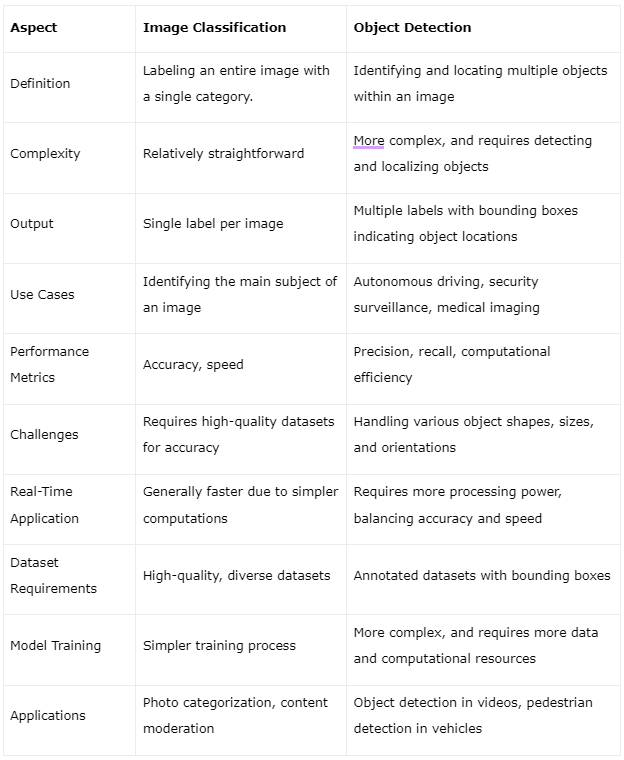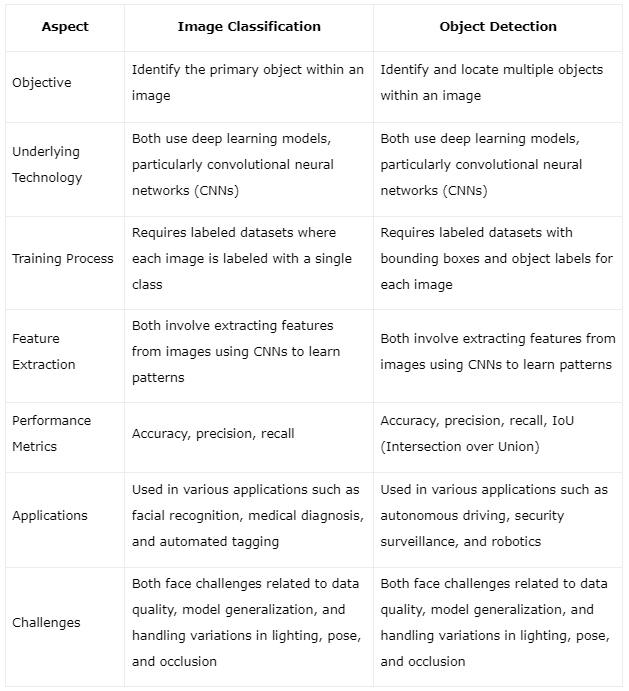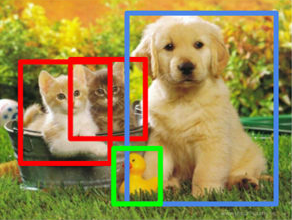Guide to Image Classification & Object Detection
Computer vision, a driving force behind global AI development, has revolutionized various industries with its expanding range of tasks. From self-driving cars to medical image analysis and virtual reality, its capabilities seem endless. In this article, we'll explore two fundamental tasks in computer vision: image classification and object detection. Although often misunderstood, these tasks serve distinct purposes and are crucial to numerous AI applications.
The Magic of Computer Vision:
Enabling computers to "see" and understand images is a remarkable technological achievement. At the heart of this progress are image classification and object detection, which form the backbone of many AI applications, including gesture recognition and traffic sign detection.
Understanding the Nuances:
As we delve into the differences between image classification and object detection, we'll uncover their crucial roles in training robust models for enhanced machine vision. By grasping the nuances of these tasks, we can unlock the full potential of computer vision and drive innovation in AI development.
Key Factors to Consider:
Humans possess a unique ability to identify objects even in challenging situations, such as low lighting or various poses. In the realm of artificial intelligence, we strive to replicate this human accuracy in recognizing objects within images and videos.
Object detection and image classification are fundamental tasks in computer vision. With the right resources, computers can be effectively trained to excel at both object detection and classification. To better understand the differences between these tasks, let's discuss each one separately.
Image Classification:
Image classification involves identifying and categorizing the entire image based on the dominant object or feature present. For example, when given an image of a cat, an image classification model will categorize it as a "cat." Assigning a single label to an image from predefined categories is a straightforward task.
Key factors to consider in image classification:
Accuracy: Ensuring the model correctly identifies the main object in the image.
Speed: Fast classification is essential for real-time applications.
Dataset Quality: A diverse and high-quality dataset is crucial for training accurate models.
Object Detection:
Object detection, on the other hand, involves identifying and locating multiple objects within an image. This task is more complex as it requires the model to not only recognize various objects but also pinpoint their exact positions within the image using bounding boxes. For instance, in a street scene image, an object detection model can identify cars, pedestrians, traffic signs, and more, along with their respective locations.
Key factors to consider in object detection:
Precision: Accurate localization of multiple objects in an image.
Complexity: Handling various objects with different shapes, sizes, and orientations.
Performance: Balancing detection accuracy with computational efficiency, especially for real-time processing.
Differences Between Image Classification & Object Detection:
While image classification provides a simple and efficient way to categorize images, it is limited to identifying a single object per image. Object detection, however, offers a more comprehensive solution by identifying and localizing multiple objects within the same image, making it ideal for applications like autonomous driving, security surveillance, and medical imaging.

Similarities Between Image Classification & Object Detection:
Certainly! Here's the content presented in a table format highlighting the similarities between image classification and object detection:

By presenting the similarities in a tabular format, it's easier to grasp how both image classification and object detection share common technologies, challenges, and methodologies, despite their different objectives in the field of computer vision.
Practical Guide to Distinguishing Between Image Classification and Object Detection:
Building upon our prior discussion of image classification vs. object detection, let's delve into their practical significance and offer a comprehensive approach to solidify your basic knowledge about these fundamental computer vision techniques.
Image Classification:

Image classification involves assigning a predefined category to a visual data piece. Using a labeled dataset, an ML model is trained to predict the label for new images.
Single Label Classification: Assigns a single class label to data, like categorizing an object as a bird or a plane.
Multi-Label Classification: Assigns two or more class labels to data, useful for identifying multiple attributes within an image, such as tree species, animal types, and terrain in ecological research.
Practical Applications:
- Digital asset management
- AI content moderation
- Product categorization in e-commerce
Object Detection:

Object detection has seen significant advancements, enabling real-time implementations on resource-constrained devices. It locates and identifies multiple objects within an image.
Future Research Focus:
- Lightweight detection for edge devices
- End-to-end pipelines for efficiency
- Small object detection for population counting
- 3D object detection for autonomous driving
- Video detection with improved spatial-temporal correlation
- Cross-modality detection for accuracy enhancement
- Open-world detection for unknown objects detection
Advanced Scenarios:
Combining classification and object detection models enhances subclassification based on attributes and enables more accurate identification of objects.
Additionally, services for data collection, preprocessing, scaling, monitoring, security, and efficient cloud deployment enhance both image classification and object detection capabilities.
Understanding these nuances helps in choosing the right approach for your computer vision tasks and maximizing the potential of AI solutions.
Summary
In summary, both object detection and image classification play crucial roles in computer vision. Understanding their distinctions and core elements allows us to harness these technologies effectively. At TagX, we excel in providing top-notch services for object detection, enhancing AI solutions to achieve human-like precision in identifying objects in images and videos.
Visit Us, www.tagxdata.com
Original Source, www.tagxdata.com/guide-to-image-classification-and-object-detection



.png)
Comments
Post a Comment